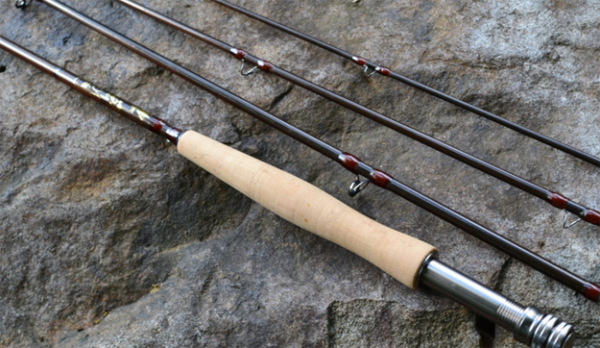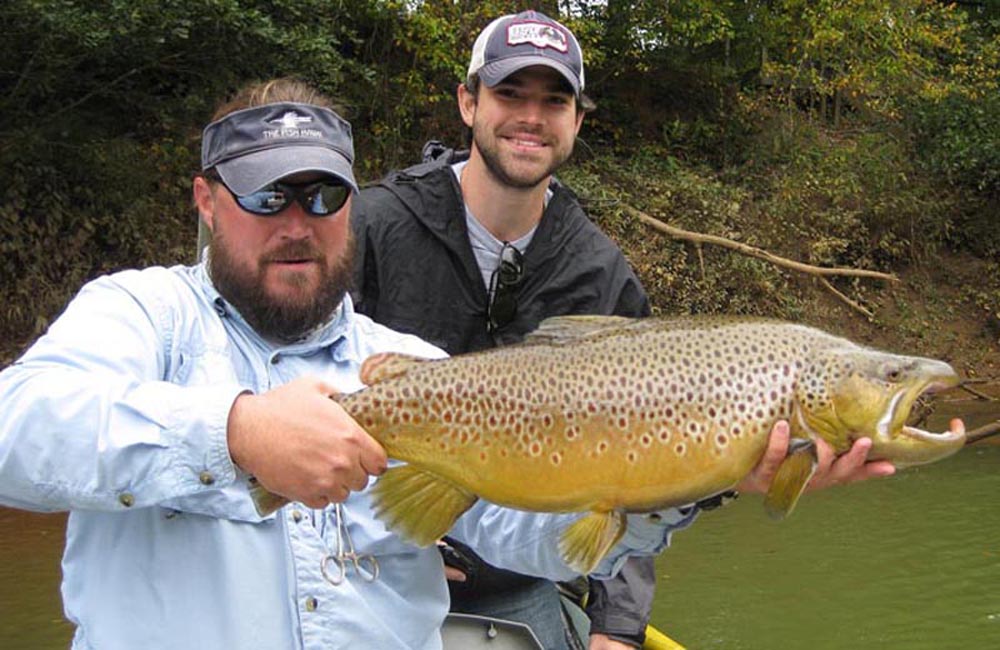Reilly Rod Crafters / Chuck Kraft Series 5-weight

Skip Clement, New Zealand. My CK five and eight have taken many scalps.
By Skip Clement
Everyone has a favorite fly rod. Most conventional length fly rods with beginner to above average at the casting end will choose 9-foot fly rods. They will generally fall in the 5/6-weight to 8/9-weight category, with fast action going to the above-average caster, slower action best for beginners, and medium action satisfying most ‘average anglers.’
This favorite rod status for me began serendipitously with a bamboo Leonard, then my 7-weight glass rod made by United States Steel Millwright angler GURU from Mckeesport, Pennsylvania. That was followed by a 1985 Graphite III RPL 10-weight from Sage. It made it to the Belize Airport, where it disappeared before landing in Pittsburgh.
From then on, the amount of destination travel increased to the point that I had rods for everything from piranha in the Orinoco and panfish to Pacific sailfish in Panama to tarpon in the Florida Keys.
Fly rod purchases were always models two or three years behind the newest and greatest fly rods
Frugality always pushed me into getting fly rods that I could cast in any condition and cast untiring all day. I would always end up with rods on their 3rd or 4th generation. I found friends with these rods and borrowed them; fly shops always had new models a couple of generations back or lightly used models.
I never fell for having a backup rod that was deficient
I would not buy a poor-casting fly rod as a backup or one with an inferior action. A backup rod in my quiver was as good as my preferred rod. It could have been better.
ICAST
At the ICAST Fly Fishing Show in Orlando in 2013, with no intent of buying anything, I met Chris Reilly who was converting ownership of a fly rod company that he managed to Reilly Rod Crafters. What turned my attention was Chris’ Chuck Kraft models that I’d guessed to be in the $750/$800 class.
On a second pass by Chris’ booth, he waved me to meet Chuck Kraft. Chuck and I hit it off. We spent hours hogging casting time at the casting pool and cast the entire Kraft line, which at the time was 4- thru 8-weight.
The Kraft line of rods was in the $350 to $450 range, as I recall.

Chris Reilly sketch by Joe Mahler.
My Reilly Rod Crafters Chuck Kraft line of rods started as a five and an eight
That was the consensus according to those we asked to review the Reilly Rod Crafters’ Chuck Kraft Series (currently available in 4-weight to 8-weight).
Who did we choose or accepted the challenge to cast and comment on the RRC 5-weight? Guides, of course, would be naturals, as would fly shop owners. Still, the inherent problem is that many of the top guides, anywhere, have decided to sign on with a rod company and get called endorsed or ambassador and other such assigned loyalist names.
Shop owners, the other natural authority, have big-time capital tied up in their chosen fly rod inventories, so asking one to comment on RRC’s non-stocked fly rods would be a biased situation. With all that said, one sponsored guide commented anonymously, as did an “off-duty” fly shop guy with whom I frequently fish.
Who was the authority worthy to comment independently on a fly rod picked?
Steve Hudson
Steve is the publisher of Chattahoochee Media, a published author of over 20 books with regional significance (Georgia and Southeast) about walk-in accesses to rivers, still waters, and backcountry trails… far from the madding crowd.
His more universal tomes cover fly tying, probably the best book ever written for beginners to intermediate level fly tyers, fly fishing, trouts and basses how-to, where to, when to for those species… it stays in my truck 24/7.

Steve with a Hootch rainbow.
His explanations of “how-to” are not always new, but the subtleties of employing them are not lost in his telling. Too, new techniques are so well explained that “stingy with words” best describes his text (he teaches college English).
Steve’s casting level is an expert. The test rod’s maximum cast distance was 103-feet (prompted by Fly Life Magazine and measured).
As a Man For All Seasons, Steve is also a rod builder, so his overview of anything put together and called a fly rod gets punished for the slightest infractions. He did not hold back on that at all.
Chad Bryson
Bryson is a full-time guide with an expert casting level. The test rod’s maximum cast distance was well over 100 feet (without prompt and not measured).
In much of North Georgia, guides, as in many such trout coordinates in the U. S. and Canada, are walk-in only or canoe/kayak capable and usually part-time, or they are skiffable with portability. That does not automatically follow that some part-timers are not experts.
Chad Bryson is a full-time fly fisherman and fly tying. His admirers say he can catch trophy trout in a puddle.
Although a tad on the serious business side, he is fun to be with and knows what he’s talking about. Without trying, even an accomplished angler marvels at his skills. Bryson can also wing a line on the money in many ways. Impressive.
BTW: Bryson has a two-handed casting school, and there are no other two-handed casting instructors in GA or NC (Federation of Fly Fishers Certified Instructors). If you’re curious about switch rods, spey rods, and how to gain an advantage casting them, jump in here.

Reilly Rod Crafters’ Chuck Kraft Series – 4- thru 8-weight. RRC image. All RRC rod are made in the United States. The Chuck Kraft Series rods are med-fast and flourish in combat.
Steve Hudson:
For casting short, 20- to 40-feet, where all the trouts, panfish, and bass are caught, this five is superior.
While I do not recall ever casting 100-feet to anything here in North Georgia, the rod delivers that distance with a forward vault that is both unusual and unexpected.
The rod load is felt to hand, so I’m going to call it a full-flex rod.
Equipage used was Reilly Rod Crafters’ Chuck Kraft Series 5-weight. Fly Line was RIO Gold Trout. The reel 3Tand TF 50 Trout Reel.

A Chattahoochee River fall wild brown trout [Salmo trutta] on a big, articulated trout streamer named Chewie, a Bryson original. Alaska, Georgia, Tennessee, North Carolina fishing guide and casting instructor Chad Bryson with a happy client. Image credit Chad Bryson. Was it the CHEWIE we knew in Star Wars? Bryson is one of the best fly fishing guides in the Southeast.
Chad Bryson:
The rod loads beautifully.
It’s a perfect fish catching rod. Fish catching here in Georgia and Alaska is done in less than 50-feet. Some of my clients own super fast rods that they should not own. Casting short, 30-to 40-feet is very difficult with a super fast rod, especially so when there’s not too much casting talent at the fisherman end. This kind of action (RRC action) is the kind I always carry on board.
I like that it is sturdily built. Even though most fly rods are “guaranteed,” a broken rod, while I’m fishing clients, is not good. I prefer high performance and sturdy. They can take a beating and keep on ticking – like this one.
The equipage used was Reilly Rod Crafters’ Chuck Kraft Series 5-weight. The fly Line ARC 5-6 weight. The reel 3Tand TF 50 Trout Reel.
Chris Reilly Rod Crafters 5-weight CONS
Steve Hudson:
As a rod builder and rod building teacher for several decades, I think there are a few very minor finish issues. There are some tiny bubbles in the finish coat around the butt.
In some areas around the ferrules, the finish is too thinned out.
I think the stripping guide is too small as are the next two guides.
This rod is slightly heavier than average for a 5-weight.
Chad Bryson:
This rod (Chris Reilly Rod Crafters 5-weight) slightly heavy for a 5-weight, so it is not in the $700- to $800 class because of that. However, a lighter version would belong there.
Wrapping Up

Matt Reilly, the owner’s son, is an accomplished angler and budding outdoor scribe. Here, he fishes a small stream in his native Virginia waters with 4-weight.
The RRC Chuck Kraft Series 5-weight fly rod is as good as it gets for anglers of any competency fishing where the trout are; 25- to 40-feet.
Its manageability is its feel of line loading the rod. No, it is not a slow action. As tested by highly skilled anglers/casters, the RRC CK five hit over 100-feet for all who handled the rod. A slow action rod could not manage that.
The luxury of this five is that it fishes all day comfortably… if you let the rod do its job.
You can learn on this rod and you will not retire it once you become competent. That is a big deal.
It was agreed that the RRC Chuck Kraft Series 5-weight fly rod could take a beating and keep on ticking. For any angler, saltwater or fresh, that has real significant relevance.
The single call-out was being a little on the heavy side. The vote on that was four, yes, and one no. The “no” is primarily a saltwater angler.
Click here for more information about Chris Reilly Rod Crafters products and services . . .


